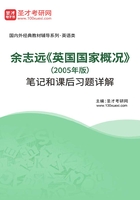
第4章 向现代时期的过渡
4.1 复习笔记
Ⅰ. Transition to the Modern Age (1455—1485)
Ⅱ.The English Reformation
Ⅲ.Elizabeth Ⅰ (1558—1603)
1. Elizabeth and Parliament
2. Elizabeth’s Religious Reform
3. Elizabeth’s Foreign Policy
Ⅳ. The English Renaissance
Ⅴ. James Ⅰ (1603—1625) and the Parliament
Ⅵ. Charles Ⅰ (1625—1649) and the Parliament
Ⅶ.The Civil Wars
Ⅷ.The Commonwealth (1649—1660)
Ⅸ. The Restoration and the Glorious Revolution of 1688
Ⅰ. Transition to the Modern Age (1455—1485)
1. The name Wars of the Roses as a series of wars between House of Lancaster and the House of York between 1455 and 1485. After the war, the great medieval nobility was much weakened and discredited. The king’s power now became supreme.
2. Henry Tudor became Henry Ⅶ (1485—1509). He gave England very firm rule.
Ⅰ.向现代时期的过渡(1455—1485)
1.玫瑰战争指的是兰开斯特王朝和约克王朝之间从1455年到1485年的一系列战争。战后,中世纪贵族大大削弱。国王的权力至高无上。
2.亨利·都铎成为亨利七世。他对英国进行了坚固的统治。
Ⅱ.The English Reformation
1. Henry Ⅷ was responsible for the religious reform of the Church. The reform began as a struggle for a divorce and ended in freedom from the Papacy.
2. Real religious change came in Henry Ⅷ’s son Edward’s time. Mary Tudor was called “Bloody Mary”. At least 300 Protestants were burnt as heretics. Protestantism and nationalism were now forever synonymous.
Ⅱ.英国的改革
1.亨利七世负责宗教改革,开始于一场离婚纠纷,以脱离罗马教皇结束。
2.真正的宗教变化发生在亨利七世的儿子爱德华统治期间。玛丽一世被称为“血腥玛丽”。至少有300名新教徒被视为异教徒而被烧死。新教和国家主义永远地成为了一体。
Ⅲ.Elizabeth Ⅰ (1558—1603)
1. Elizabeth and Parliament
Elizabeth was able to work with Parliament. But her relationship with Parliament was often turbulent.
2. Elizabeth’s Religious Reform
Elizabeth broke Mary’s ties with Rome and restored Church of England. Elizabeth Ⅰ spent nearly 20 years resisting Catholic attempts to either dethrone or assassinate her.
3. Elizabeth’s Foreign Policy
For nearly 30 years Elizabeth successfully dealt with the relationship with France and Spain, and prevented England from getting involved in any major European conflict.
Ⅲ.伊丽莎白一世 (1558—1603)
1.伊丽莎白和议会
伊丽莎白可以和议会一起工作,但是她和议会的关系经常混乱不清。
2.伊丽莎白的宗教改革
伊丽莎白打破了玛丽和罗马的联系,恢复了英国国教。伊丽莎白用了将近20年的时间躲避天主教对她的废黜或暗杀。
3.伊丽莎白的对外政策
近30年,伊丽莎白成功地处理了英国和法国、西班牙的关系,并避免了英国卷入主要欧洲国家的纷争。
Ⅳ. The English Renaissance
1. Renaissance was the revival of classical literature and artistic styles in European history. The Renaissance began in Italy in the early 14th century.
2. The English Renaissance was largely literary, and achieved its finest expression in Elizabethan drama. Its finest exponents were Christopher Marlowe, Ben Jonson, and William Shakespeare.
Ⅳ.英国的文艺复兴
1.文艺复兴指的是欧洲历史上古典文化和艺术形式的复兴。文艺复兴开始于14世纪早期的意大利。
2.英国的文艺复兴主要是文学成就,尤其是伊丽莎白时期的戏剧。集大成者当属克里斯多夫·马洛,本·琼森和威廉·莎士比亚。
Ⅴ. James Ⅰ (1603—1625) and the Parliament
James I, a firm believer in the Divine Right of Kings, would have preferred no Parliament at all and actually did without one for seven years.
Ⅴ.詹姆斯一世和议会
詹姆斯一世是君权神授的坚定维护者,他更希望没有议会,事实上在他统治的七年里也没有议会。
Ⅵ. Charles Ⅰ (1625—1649) and the Parliament
Charles I’s relations with the Parliament were disastrous. Charles, being still in want of money, called his Fifth Parliament. Then a whole series of measures were introduced by the Long Parliament limiting the authority of the Crown while increasing its own. The conflict was inevitable and the civil war broke out.
Ⅵ.查尔斯一世和议会
查尔斯一世和议会的关系是灾难性的。查尔斯由于财政短缺而召集他的第五次议会。长议会采取了一系列措施限制国王的权力,增加自己的权力。冲突是不可避免的,于是内战爆发了。
Ⅶ.The Civil Wars
The First Civil War began in 1642. Induced by Charles, the Scots invaded England, but were defeated by Cromwell (1648). This was the beginning of the Second Civil War. Charles was beheaded in 1649 and Oliver Cromwell became the most powerful man in England.
Ⅶ.内战
第一次内战开始于1642年。苏格兰受查尔斯的引诱,入侵了英格兰,但是在1648年被克伦威尔所打败。这是第二次内战开始的标志。1649年,查尔斯被送上了断头台。克伦威尔成为英国最有权力的人。
Ⅷ.The Commonwealth (1649—1660)
1. After King Charles’s execution in 1649, Young Charles escaped to France. The Second Civil War was over.
2. Oliver Cromwell declared England a Commonwealth. He became Lord Protector of the Commonwealth of England.
Ⅷ.共和国 (1649—1660)
1. 1649年查尔斯死后,他的儿子流亡法国。第二次内战结束。
2.克伦威尔宣布英国为英联邦,并成为英联邦的护国者。
Ⅸ. The Restoration and the Glorious Revolution of 1688
1. After Oliver Cromwell died, Richard succeeded the crown. George Monck occupied London. The Parliament in 1660 resolved the crisis by asking the late King’s son to return as King Charles Ⅱ (1660—1685). The Restoration was relatively smooth.
2. After Charles Ⅱ died, James Ⅱ succeeded the crown. He was a Catholic, and hoped to rule without giving up his personal religious views.
3. The English politicians rejected James Ⅱ and invited Mary and her husband William to take the English throne in 1688. This became known as the Glorious Revolution. Thus the age of constitutional monarchy, of a monarchy with powers limited by Parliament, began.
4. In 1702, Mary’s sister, Anne, came to the throne. It was during Anne’s reign that the name Great Britain came into being when, in 1707, the Act of Union united England and Scotland.
Ⅸ.复辟时期和1688年的光荣革命
1.克伦威尔死后,查理德继位。乔治·蒙克占领了伦敦。1660年,议会允许已故国王的儿子回到英国,作为查尔斯二世,进而解决了危机。复辟时期相对平稳。
2.查尔斯二世死后,詹姆斯二世继位。他是天主教徒,希望能按照自己的宗教观点统治国家。
3.英国的政治家们拒绝了詹姆斯二世,于1688年邀请了玛丽和她的丈夫威廉共同执政,这就是著名的光荣革命。从此,君主立宪制开始了,国王的权力受到议会的限制。
4. 1702年,玛丽的妹妹安妮继位。在安妮统治期间,1707年《联合法案》统一了英格兰和苏格兰,大不列颠正式成立。